Secrets of the Old Town
Secrets of the Old Town
►Unveil the secrets of Barcelona without rush!
►An extended tour of historical city center
►History, mysteries and legends of Gothic Quarter, Raval and Born
Combine this tour with our tours Gaudí and Modernism and Barcelona by bike!
There are the KEY STOPS and the MAIN TOPICS of the Historical city centre tour – for the most curious ones!
 |
The place of foundation of Barcelona
• A 16,9 meters high hill on Paradise Street - is where the story begins! • The Romans did not do anything just for the sake of it. Find out, why they chose this very spot, where were the cardus maximus and decumanus maximus of the Roman Barcino and what the city looked like at that time. • Come up to the columns of the temple of August located in the very heart of the city. |
 |
The Roman wall
• 1.270 meters long, between 8 and 18 meters high, and between 2 and 5 meters thick. During our excursion we are going to see it`s remains from outside and inside in various parts of the historical centre, and even lean on it while having a coffee in one of the cafes… • We will tell you about different stages of the construction of the wall. • How Barcelonans have taken advantage of the wall and its towers during all its history, from being a fortification for protection of the Roman city to the shops and apartments of today? |
 |
New Square (Plaça Nova)
• Scientific and mythical theories of the name of Barcelona. • Humans have already inhabited this zone for thousands of years. You will get to know about the first tribes of this site and the nations that have lived in Barcelona during its history. • A dancing egg, the sardana dance, Christmas fairs… We will tell you about these and other interesting activities that take place on this square of the city. |
 |
Picasso frieze
• It is a well-known fact that Picasso spent a few years of his life in Barcelona. In this friso he represented some festivals and traditions of the region – as well quite famous ones as unknown ones, although authentic and very ancient. • The archbishop of Barcelona did not like seeing these sgraffitos in front of the main cathedral of the city. We will tell you how the architect persuaded him by some unexpected but effective means. • The talent that prevailed upon political disagreement – the history of one friendship between a fascist and a communist. |
 |
The Cathedral (Catedral de Barcelona)
• How many years had the construction lasted until the cathedral got its actual appearance? • Why do 13 geese live in the cathedral? • We will teach you to read and to “decode” some lapidarian “messages from the past” that can be found on the walls of the cathedral and around it. |
 |
Saint Philip Neri Square (Plaça de Sant Felip Neri)
• Why famous Gaudí frequently came to this mysterious and Romantic corner of the city, where a portrait of the master is hidden. • We will see a reminder of horrors of the civil war in this square, where new tactical techniques were tested. • "Travelling buildings" of Barcelona. |
 |
King`s Square (Plaça del Rei)
• The Royal Palace was a residence of the counts of Barcelona and kings. • This square is a place where the judgements were pronounced and the executions of criminals and heretics were carried out for several centuries. Fancy knowing more thrilling details? • Where in the city can you travel in time by an elevator? |
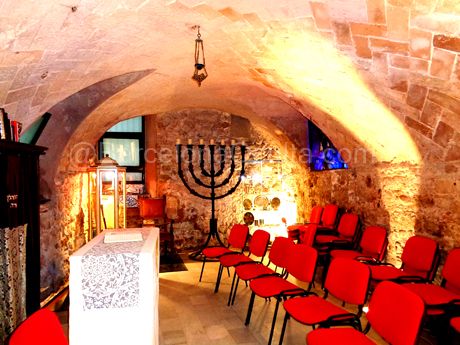 |
The Jewish community of Barcelona
• We are going to pass by one of the oldest synagogue in Europe. • We will find the traces of Jewish presence in different parts of the historic city centre, including some places where you least expect it. • We are going to tell you some real stories and charming legends about life of Jewish community of medieval Barcelona. |
 |
Knights Templar of Barcelona
• Not much is left from this order that once was powerful and influential in all Europe and in Barcelona. We will show the few reminders of the Templar knights and tell you their tragic story. • Do you know what inventions of the Templars made “just” Christians very suspicious? • Templar governors of Barcelona. |
 |
The streets of Gotico
• The street whose characters Picasso painted in one of his world famous works. • A square named in honour of a prominent British writer George Orwell. • The “round” square and more… |
 |
Basilica of our Lady of Mercy (la Basílica de la Mare de Déu de la Mercè)
• How locusts caused trouble between saints? • Why, according to a popular legend, it normally rains on September 24 in Barcelona? |
 |
Archbishop`s bridge (Puente del obispo)
• A postcard view of Barcelona looks medieval, but it`s a trick – do you know how old it is in fact? • We will look for a mysterious skull, hidden among the decorations of the bridge and wrapped in a number of legends. • Where in the busy centric street full of tourists do the medieval witches hide? |
 |
Barcelona`s town hall (Ajuntament de Barcelona) and the Government of Catalonia (Generalitat de Catalunya)
• Here you are going to get to hear the history and some legends around the flags of Catalonia and Barcelona. • The square that has been the administrative centre of the city for many centuries, where we will find even some pieces of the legendary city of Troy! • What day is Catalan traditional “analogue” of Saint Valentine`s day and how is it celebrated? |
 |
Basilica of Saints Justus and Pastor (Basílica dels Sants Màrtirs Just i Pastor)
• Do you have an idea of how this church is related to the constellation of Gemini? • What is the connection between this church and the most famous idol of Barcelona – the virgin of Montcerrat? • What treasures are kept in its interior? |
 |
Royal Square (Plaça Reial)
• What does this square have to do with monkeys and coffee (other than you can have one in one of the cafes situated at the square)? Find out with us. • What architectural trick was applied in order to conceal the imperfect shape of this square? • Here we will find some works of Gaudí, designed at the beginning of his life and career as an architect. |
 |
Basilica of Saint Mary of the Pine Tree (Basílica de Santa Maria del Pi)
• What was here before this church and why is its name so unusual? • You will know by name all the bells of its bell tower and learn about the role of this bell tower in history of Barcelona. • What did fashion shows of Barcelona look like in the past? |
 |
The Church of Santa Anna (Església de Santa Anna)
• A quiet hidden place in the heart of the city. • The ancient and actual state of the order of Order of the Holy Sepulchre. • This church is an appropriate place to talk about the most notable orders in history of Barcelona and Spain. |
 |
The “street of witches”
• We will bring you to the place where one can “buy” the Stone of the Eternal Youth. • Appreciate the cutest and the most unusual sign plates and walls decorations in the city. |
 |
A stroll down the Ramblas
• Las Ramblas is a fresh pedestrian zone where one can find a lot of stalls with souvenirs, food and flowers. • The legend of a cursed theatre and others – Rambla is full of urban legends! You will find out, about the first cinema, designed by Gaudi, a henhouse at this street, a cursed theatre, popular characters of the neighborhood and many other details about this street! • Where do football fans celebrate victories of their favourite teams? |
 |
Boqueria market (Mercat de Sant Josep de la Boqueria)
• Here one can see Spanish and foreign fruit of unbelievable colours, some strange sea creatures that you probably have never seen before and of course the traditional Spanish jamón… And all that you can buy and try right there! • The meaning of the name and the things that happened here. |
 |
Old Hospital of the Saint Cross (Hospital de la Santa Creu)
• One of the oldest hospitals of Europe that functioned for 500 years, where the best doctors of different periods worked and where the poor were treated along with some famous historic personalities. • Try to guess, what is the connection between such a sad place as a hospital and a merry place like a theatre? |
 |
Botero`s cat
• We bet it`s the fattest cat in the world! The most daring ones can climb up the cat and take some photos on him. • A cute work of art of contemporary renowned sculptor Fernando Botero. You may even remember seeing some other his works in Barcelona or possibly even in your city! • The cat has been in various places of Barcelona, but why after all he has settled here? |
 |
El Raval – an old industrial district of Barcelona
• A controversial district, where in different periods of its history some monasteries, vegetable beds and farms, hospitals and industries would be situated, and monks, farmers, lepers and other sick people, orphans, workers, craftsman and criminals would live… • During its history the district became notorious. We will tell you about the scariest crimes that happened here. • What did Barcelonans of the past do with unwanted children? |
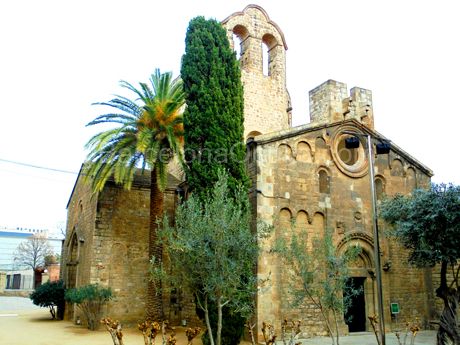 |
Monastery of “Saint Paul of the countryside” (Sant Pau del Camp)
• The only monastery that remains in Raval today and one of the oldest in the city. • What are some frogs doing in the cloister of the monastery? |
 |
Rambla of the Sea (Rambla del Mar)
• Barcelona has been a port city from the very beginning, the fact that of course influenced its history a lot. Let´s appreciate the modern port área! • World famous characters that have visited this city during its history: Christopher Columbus, Miguel de Cervantes and many others. |
 |
Güell Palace (Palau Güell)
• The names of Gaudí and his art patron Güell are probably the most pronounced in Barcelona. Who were these personalities and what were their destinies? • One of the first “underground parking lots” in Barcelona where cars never were parked… It was under this building! |
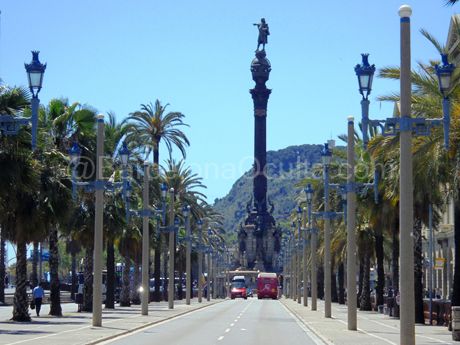 |
Monument to Columbus
• What is he pointing at with his hand? One might think at America, but it is not true… • Why did he try to conceal his origin? It is not certain, but we will offer you a theory. • Why some marijuana leaves appear on the monument? |
 |
Basilica of Saint Mary of the Sea (Basílica de Santa María del Mar)
• Theories of the name of the church and why it was once called “of the sands”. • Find out how it happened that inside of a church a stained-glass window that represents the logo of “Barça” football club can be found. • This place is also related to a tragic event in the history of Catalonia. It is a place to talk about Catalan independence movement. |
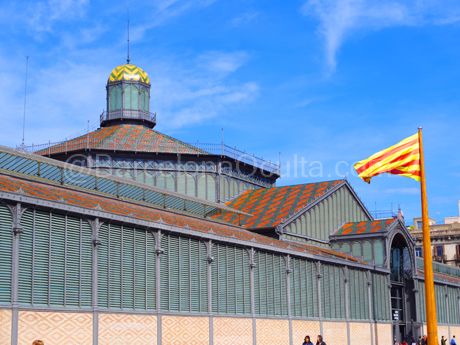 |
Born district
• Where did Barcelonians buy coffee, tobacco and ice, gambled, fought at tournaments, and visit women a few centuries ago? • Why did the Barcelonians of the 18th and 19th centuries dislike this area and a nearby park, so popular in the present days? How many building are in the shortest street of Barcelona, and where is the narrowest one? • How a new statue suddenly boosted the sales in a neighbouring market? |
 |
Roman necropolis
• How a necropolis was found in the very city centre? • Why did the Romans bury their loved ones outside of the city walls, but along the roads that lead to the city? • Who are the people buried here about two thousand years ago, what are the names and how do we know that? |
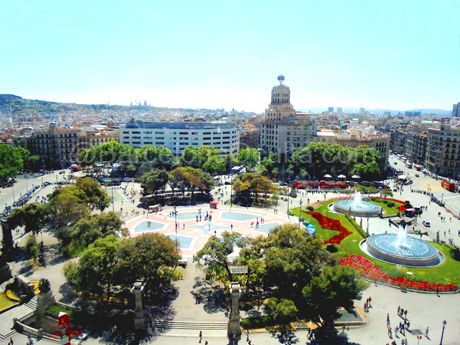 |
Catalonia Square (Plaça de Catalunya)
• What animal hides here in front of everybody`s eyes? • What little statue, also hidden, animated Barcelonians during hard times? • Where was one of the biggest underground shopping centre of Europe? |
☆ The sequence of the visit to the sights listed above can change depending on the opening hours of the museums, public activities in the city, start time and place and other reasons.
☆ In addition to the sites above we will certainly show you more curious things and tell more stories.
☆ Optional visits are available on the working days of the museums.
Characteristics of the tour
• Duration: approximately 8 hours.
• In case if you need a lunch break during the tour, the guide will recommend you a café or a restaurant to suit your preference.
• Availability: daily from 9 am till 9 pm local time. It`s advisable to start the tour in the morning.
• The tour can only be undertaken on foot.
• Price: Ask the price
• Recommended for: those travellers who would like to explore the city in more details and without rush and have enough time for that.
• We recommend you to combine this excursion with the Gaudí and Modernism and the Tour by Bicycle.
• Observations: the only way to experience the historical city centre is on foot. Please take into account that on this tour you will have to be on your feet for about 8 hours. Nevertheless, it is possible to make breaks and stop for a while during the tour. The narration is full of details, history and anecdotes. We know it is going to capture your attention and even though 8 hours might sound a long tour we will make that time fly!
Enjoy the tour!




